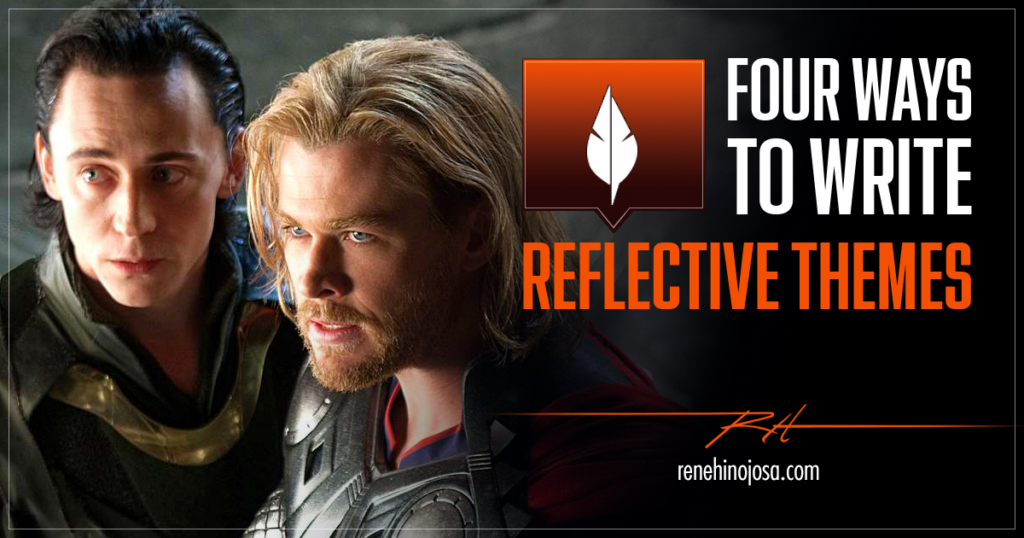There’s something about duality. It’s a principle often representing a dynamic balance of opposing yet complementary forces. The Chinese philosophy of yin and yang perfectly symbolizes this idea, illustrating duality’s comparative and reflective nature and how we can perceive it physically and immaterially.
These philosophical concepts offer rich and profound possibilities for any writer. But how do we incorporate them into our stories? How does duality relate to plot, setting, characters, and theme? To answer those questions, I’ll explore how to write reflective themes using Thor as a case study.
Four Ways To Write Reflective Themes:
Duality And Theme
By its very nature, theme perfectly fits with the concept of duality. Its foundation is anchored in the opposition of lie and truth, and its framework is mirrored in the relationship between internal and external conflict. All of this culminates in a resolution designed to balance the entire construct.
Understanding this enables you to write reflective themes. And while many stories incorporate this idea, Thor stands as a masterclass in how to use duality to its full potential.
Reflective Conflict
Reflective themes are best explored through protagonists and antagonists who are mirror opposites. Although they may have the same thematic goals, their ideals and methods are directly opposed, making them two sides of the same coin.
In Thor, we’re introduced to Thor and Loki. Both have aspirations to become the next king of Asgard. However, only one can ascend to the throne despite their father’s declaration that they were both born to be kings.
Thor and Loki have the same goal: to be king and please their father, but neither has the right qualities. Thor is brash and arrogant, and in his eagerness to wield power, he threatens the peace and stability of Asgard and the nine realms. Odin strips him of his power for his actions and banishes him to earth.
Loki’s calm and reserved demeanor disguises his true nature as a deceiver and master manipulator, skilled at using his enemy’s weaknesses against them. And while his ambition is equal to Thor’s, it soon spirals out of control when he learns the secret of his true parentage.
Both Thor and Loki are unworthy. Each reflects greed and selfish ambition. Both are deceived by the same lie, which causes them to value themselves over others. As the story unfolds, they are both presented with the opportunity to embrace the thematic truth centered on valuing others over oneself.
Reflective Worlds
Setting can be an extension of your characters and their emotional state, providing insight into their internal conflicts. Consider how the thematic elements of your characters’ arcs can be reflected through the world or worlds they inhabit.
Earth represents Thor’s descent from god to mortal. Upon learning that S.H.I.E.L.D. has found his trusty hammer, Mjolnir, he assumes he can go in and take back what belongs to him. But he soon discovers he’s not up to the challenge.
The primordial mud is a nice visual cue that shows how far Thor has sunk in his fall from grace. He screams in anger and anguish at his inability to retrieve his hammer, experiencing what it’s like to be completely and utterly powerless.
Meanwhile, Loki experiences the euphoria of power as he uses deceit to ascend to the throne. Once he seizes power, Asgard becomes noticeably darker and enveloped in shadows, symbolizing what happens when greed and self ambition are allowed to rule.
Earth reflects Thor’s descent into powerlessness, while Asgard reflects Loki’s rise to power. It’s a brilliant example of how the worlds in a story can serve as thematic cues that drive the narrative forward.
Reflective Motives
Consider giving your protagonist and antagonist reflective motives spawned by their unique inner conflicts. This will allow you to craft a climax in which their reflective thematic arguments inevitably clash.
Thor’s descent into humility ultimately causes his motives to change. He forsakes his brash and arrogant attitude and warms up to those he previously thought were beneath him. And at the cost of his own life, he finally puts the needs of others above his own.
But while Thor learns to embrace the story’s thematic truth, Loki plunges further into the lie, believing that his display of power will ultimately make him worthy of the throne and his father’s love.
Reflective Resolutions
Stories with contrasting themes can be resolved in several ways. Still, the most effective resolution leaves the protagonist and antagonist in a stalemate, where their ideas remain perpetually opposed.
After his defeat, Loki attempts to justify his actions as a gesture worthy of his father’s approval. But Odin’s refusal to acknowledge him leaves him hopelessly lost, and he chooses to let go of Asgard and his father forever.
By contrast, Thor’s choice to embrace humility leads him to refrain from accepting the throne, citing that he still has much to learn. Odin declares his approval of him and who he has become.
Both character arcs come to a satisfying conclusion while creating a scenario in which Loki and Thor remain directly opposed. This stalemate preserves the nature of duality, perfectly balancing the beginning, middle, and end.
Summing It Up
Understanding the concept of duality and how to use it to write reflective themes can help you elevate your story to a new level. Weaving these ideas into your plot, characters, and settings creates a strong and cohesive balance that carries your story from beginning to end.
I hope this article provided you with some insight on how to write reflective themes. I invite you to explore the concept for yourself. Look for ways to incorporate it into your work. And above all, keep writing!
Until next time,

